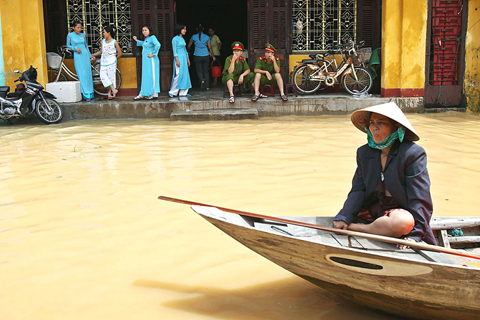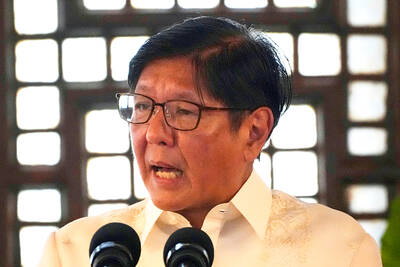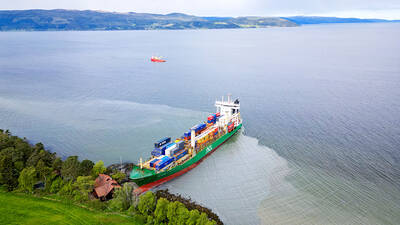Typhoon Ketsana extended its destructive rampage through Southeast Asia yesterday, blowing away whole villages in Vietnam, Cambodia and Laos as the regional death toll rose to 312.
The storm has unleashed some of the worst flooding in a decade and left governments in the disaster-prone region struggling to help more than 2 million people who are either homeless or in urgent need of supplies.
“I have never seen such a strong wind in my life,” Pang Phot, a police officer in Cambodia’s badly hit Sandann district, said by telephone.

PHOTO: EPA
Landslides buried homes and rising waters threatened ancient world heritage sites as the storm finally moved inland toward Laos and weakened to a tropical depression yesterday.
Ketsana killed 246 people in the Philippines over the weekend while still a weaker tropical storm, before strengthening into a typhoon over the South China Sea and smashing into central Vietnam on Tuesday, leaving another 55 dead.
The typhoon moved inland to lash Cambodia overnight, killing 11 more people, and caused meter-high flooding in Laos yesterday. Authorities in northeastern Thailand were also on high alert, but said there had been no damage yet.
Vietnam’s flood and storm control committee listed 11 missing in addition to the 55 confirmed dead. The toll included 13 in mountainous, inland Kon Tum Province and 14 in central Quang Ngai Province, where the typhoon made landfall.
On Tuesday flooding hit parts of Danang as well as Hue, the former capital and a World Heritage site, where residents used small wooden and steel boats to move around.
The flood and storm control committee said that six coastal provinces had been evacuated, involving 168,585 people. Many areas were without power.
Vietnamese Deputy Prime Minister Hoang Trung Hai said military helicopters could be sent to join the rescue effort, adding that they would immediately evacuate households on river banks and areas likely to suffer from landslides.
In Cambodia, authorities said the homes of thousands of people had been evacuated as the storm packed winds of up to 145kph.
Nine were killed and 28 injured in central Cambodia, while two died in the northeast overnight as the country was battered by the storm, officials said. The victims included a grandmother, mother and three children in one house.
“At least nine people were crushed last night when their houses fell down,” said Chea Cheat, chief of the Red Cross office in central Kampong Thom Province, adding that at least 92 houses in his province were destroyed.
In deeply impoverished and isolated Laos, five or six villages had reportedly been flooded in Savannakhet Province and aid workers were making their way there by car, aid agency World Vision said.
“We have the capability to urgently ready 500 aid packs if our assessment teams find these are needed,” World Vision aid worker Vatthanathavone Inthirath said.
In the Philippines, Ketsana dumped the heaviest rains in more than four decades on Manila and surrounding areas on Saturday, submerging 80 percent of the city.
Meanwhile there were warnings that another looming typhoon may add to the devastation. Typhoon Parma was lurking to the east of the Philippines and on course to hit the country today or tomorrow.
Also See: EDITORIAL: Lessons from the Philippines

NO EXCUSES: Marcos said his administration was acting on voters’ demands, but an academic said the move was emotionally motivated after a poor midterm showing Philippine President Ferdinand Marcos Jr yesterday sought the resignation of all his Cabinet secretaries, in a move seen as an attempt to reset the political agenda and assert his authority over the second half of his single six-year term. The order came after the president’s allies failed to win a majority of Senate seats contested in the 12 polls on Monday last week, leaving Marcos facing a divided political and legislative landscape that could thwart his attempts to have an ally succeed him in 2028. “He’s talking to the people, trying to salvage whatever political capital he has left. I think it’s

Polish presidential candidates offered different visions of Poland and its relations with Ukraine in a televised debate ahead of next week’s run-off, which remains on a knife-edge. During a head-to-head debate lasting two hours, centrist Warsaw Mayor Rafal Trzaskowski, from Polish Prime Minister Donald Tusk’s governing pro-European coalition, faced the Eurosceptic historian Karol Nawrocki, backed by the right-wing populist Law and Justice party (PiS). The two candidates, who qualified for the second round after coming in the top two places in the first vote on Sunday last week, clashed over Poland’s relations with Ukraine, EU policy and the track records of their

UNSCHEDULED VISIT: ‘It’s a very bulky new neighbor, but it will soon go away,’ said Johan Helberg of the 135m container ship that run aground near his house A man in Norway awoke early on Thursday to discover a huge container ship had run aground a stone’s throw from his fjord-side house — and he had slept through the commotion. For an as-yet unknown reason, the 135m NCL Salten sailed up onto shore just meters from Johan Helberg’s house in a fjord near Trondheim in central Norway. Helberg only discovered the unexpected visitor when a panicked neighbor who had rung his doorbell repeatedly to no avail gave up and called him on the phone. “The doorbell rang at a time of day when I don’t like to open,” Helberg told television

‘A THREAT’: Guyanese President Irfan Ali called on Venezuela to follow international court rulings over the region, whose border Guyana says was ratified back in 1899 Misael Zapara said he would vote in Venezuela’s first elections yesterday for the territory of Essequibo, despite living more than 100km away from the oil-rich Guyana-administered region. Both countries lay claim to Essequibo, which makes up two-thirds of Guyana’s territory and is home to 125,000 of its 800,000 citizens. Guyana has administered the region for decades. The centuries-old dispute has intensified since ExxonMobil discovered massive offshore oil deposits a decade ago, giving Guyana the largest crude oil reserves per capita in the world. Venezuela would elect a governor, eight National Assembly deputies and regional councilors in a newly created constituency for the 160,000